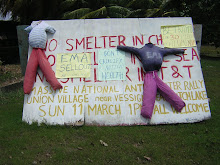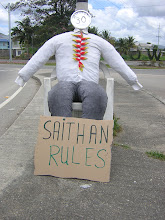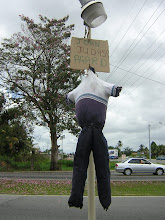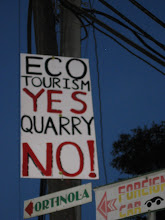The Truth Drummers say that any declarations signed committing to environmental sustainability would be hypocritical because T&T is depleting its energy resources as fast as is technologically possible to meet the demands of the USA, foreign corporations and a handful of local elites. The price of this ‘gas stripping’ remains unknown (“in an abundance of water the fool is thirsty...Rat Race”, Bob Marley).
This posting seeks to demonstrate that T&T is on an anti-sustainable path by examining the quarrying sector.
Before we begin, let us accept the definition of sustainable development in its broadest possible terms - as meeting the needs of the present generation without compromising the ability of future generations to meet their own needs.
Let us also remind ourselves that the World Summit for Sustainable Development (Rio plus 10, Johannesburg, 2002) declared that “there must be at the domestic level, sound environmental, social and economic policies, and democratic institutions responsive to the needs of the people.”
Let us start our demonstration with an overview of the role of Environmental Management Authority (EMA) which began operations in June 1995 with start up money from the World Bank and a mandate to “write and enforce laws and regulations for environmental management, to educate the public about the nation's environmental issues and to control and prevent pollution, as well as conserve natural resources.” (EMA website). The principle environmental legislation enacted so far is the Environmental Management Act of 2000.
The EMA’s National Environmental Policy (revised in September, 2005) states “Moreover, the development of the petroleum and petrochemical sector has expanded to the extent that T&T is now the largest supplier of natural gas to the USA and the number one exporter of ammonia in the world. These developments have given the country global recognition and attention. The Government is therefore duty bound to ensure that T&T finds the right balance between economic development and environmental conservation.”
This Policy recognizes the environment as “an essential pillar of economic and social development and consequently environmental sustainability is a key objective of economic development planning”...in formulating this Policy...“the government focused on the sustainable management of the country’s environmental assets rather than the narrower concept of environmental protection, which tends to bring into conflict environment and development. The Policy therefore assures that economic development is not undermined by the unsustainable use of our environmental assets.”
The EMA is the focal point of development decision making since one of its functions is to issue Certificates of Environmental Clearance (CEC) to new development projects that may impact the environment. Where environmental impacts are expected to be significant the developer is required to engagethe services of a suitable consultant to undertake an Environmental Impact Assessment (EIA).
'Mining' (quarrying) was included in the ‘List of Designated Activities’ (Activity 23, established by Order 103 in 2001) which under the CEC Rules required an EIA.
The EMA’s 2004 State of the Environment Report is an assessment of the contribution of ecosystem services of the Northern Range (NR) of Trinidad and Tobago to human well-being. "It is the result of a remarkable jointly lead pro bono collaboration between several civic society organizations and private individuals with the EMA and employees of several government Ministries and agencies acting in their personal capacities” (former Chairman of the Board Dr. John Agard).
This Report is important because 80% of our drinking water comes off the NR – a mountainous region running east-to-west along the north coast, covering about 25% of Trinidad’s land area and obviously the most important watershed on the island. The findings of the EMA's Report include:
- 33 quarries operating in the NR
- the environmental effects of uncontrolled quarrying create major problems for persons who live in or use the immediate environs of the quarries
- NR watersheds are becoming more degraded
- declining trend in fresh water fish catch and
- quarry operations are dictated by business economics to the exclusion of environmental situation…and aggravated by poor level of control over the industry
The Report goes on to state “the Water and Sewage Authority (WASA) spends $TT 13.4M per month (Million) on desalination water which accounts for 10% of total supply and….. if WASA had to substitute the surface water supplied by the Northern Range for desalinated water, this would cost “$TT 107M /month.”
The Report recommended:
- Accelerate revision of the Quarry policy and increase threshold for good practice in this sector
- Give priority to rehabilitation and restoration where possible to abandoned quarry sites to arrest erosion and run-off
- Disallow further quarrying in the NR and if necessary import aggregate
- Bring into the regulatory framework quarries that pre-existed the EM Act
The Report also noted that “the situation in the Northern Range could be helped if there was a champion of the issues at the political level.”
Switching now to the related Ministry of Energy and Energy Industries, which is responsible for issuing mining (quarry) licenses. Their 2005 draft Green Paper on Quarry Policy states that “the Trinidad and Tobago quarry industry in 2004, comprised fifty-six (56) active quarries of which thirty-eight (38) are sand and gravel quarries. Of the sand and gravel quarries twelve (12) were operating illegally.
The Green Paper recognizes that “growth and development of the energy sector and that of the construction sector in Trinidad and Tobago are highly correlated” and that “the current high level of growth in the construction sector is reflected in soaring demand for quarry materials and has stimulated a high degree of activity in the sector.”
Quoting further from the Policy: “Possible quarry reserves as at January 1, 2004 in Trinidad and Tobago were 2,530 million cubic yards spread over 8,430 acres. The lack of proper legal arrangements and other shortcomings in the administration of the sector became more obvious as it led to an unprecedented spate of illegal quarrying..."
Based on data included in the Green Paper, over 90% of quarrying activity takes place in the Northern Range.
The major quarry Policy goal stated is to “promote sustainable development of the quarry industry of Trinidad and Tobago for the benefit of its people in an environmentally sound manner and consistent with Government’s macroeconomic policy.”
The Green Paper acknowledges the following shortcomings in the sector:
- absence of regulations to grant quarry licenses
- ambiguity with respect to the procedures for assigning and terminating licenses
- conflicts with existing legislative provisions e.g. the Environmental Management Authority Act
- ineffective and deficient regulatory control
- inappropriate legislative mechanisms and Institutional weaknesses
- currently the quarry industry in Trinidad and Tobago is deluged with environmental problems. These are being addressed as a matter of urgency
That is the background. Now let us see what happened next...
Astonishingly to the naive, in 2007 and 2008, two successive Ministers with Environmental portfolios reversed the Certificate of Environmental Clearance (CEC) Rules to ensure that new quarry applications would no longer be subject to any form of social and environmental assessment or scrutiny! (Presumably not the "political level champion sought by EMA).
The first reversal or 'anti-sustainable development blow' was made by former Minister of Public Utilities and Environment, Penelope Beckles (she is now Speaker of House) – through Legal Notice 164, July 2007. The second anti-sustainable development blow was made by the current Minister of Planning, Housing and Environment, Dr. Emily Dick-Forde – through Legal Notice 186, November 2008).
Penelope Beckles’ Order made sure that no application for quarries less than 150 acres would be subject to an Environmental Impact Assessment (EIA)! (no quarry is as big as this mind you). The result was impressive, by the end of 2007 there were 17 new applications for quarries and a withdrawal of a pending application, submitted before the Order (for a quarry in Ortinola, Acono, in the Maracas Valley, in the centre of the Northern Range).
In her haste to open the quarrying flood gates, however, ex-Minister Beckles overlooked another ‘Designated Activity’ in the CEC Rules, (8c) one for “ the clearing, excavation, grading or land filling of any area with a gradient of 1:4 or more” which also required that an Environmental Impact Assessment be performed. But no worries, up stepped Minister Dick-Ford to take care of any residual 'sustainability loopholes'.
Her December 2008 Order exempted quarrying activity from any such assessment. Again, these 'environmental hating' actions might appear astonishing to the naive but are par for the course, if one is following the leader carefully. Of course Minister Dick-Forde's Order is ludicrous as essential quarry operations are "clearing, grading, excavating and backfilling!"
Conclusion
Successive Ministers responsible for the “environment” have sacrificed declared policy and sustainability goals to serve perceived economic gains in the energy and construction sectors. The consequences of this sacrifice are profound; not only are the resources of the Northern Range being denied to future generations, not only are people living there right now suffering from reduced quality of life, but the integrity of the supposed democratic process and trust in Government institutions to look after the well being of present and future generations, are also shattered.
Truth Drummers have used the quarry sector to demonstrate ‘anti-sustainable development' with far reaching and destabilizing implications. The hypocrisy of T&T’s Government signing a ‘Declaration of Commitment’ to sustainability at the up-coming Summit while doing the opposite at home is why we will Drummit to the Summit.


















































No comments:
Post a Comment